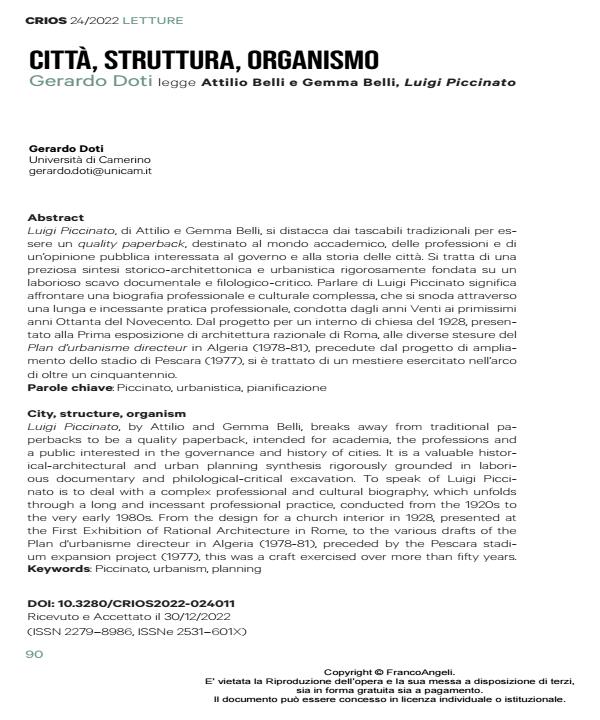City, structure, organism
Journal title CRIOS
Author/s Gerardo Doti, Attilio Belli, Gemma Belli, Luigi Piccinato
Publishing Year 2024 Issue 2022/24 Language Italian
Pages 16 P. 90-105 File size 874 KB
DOI 10.3280/CRIOS2022-024011
DOI is like a bar code for intellectual property: to have more infomation
click here
Below, you can see the article first page
If you want to buy this article in PDF format, you can do it, following the instructions to buy download credits

FrancoAngeli is member of Publishers International Linking Association, Inc (PILA), a not-for-profit association which run the CrossRef service enabling links to and from online scholarly content.
Luigi Piccinato, by Attilio and Gemma Belli, breaks away from traditional paperbacks to be a quality paperback, intended for academia, the professions and a public interested in the governance and history of cities. It is a valuable historical-architectural and urban planning synthesis rigorously grounded in laborious documentary and philological-critical excavation. To speak of Luigi Piccinato is to deal with a complex professional and cultural biography, which unfolds through a long and incessant professional practice, conducted from the 1920s to the very early 1980s. From the design for a church interior in 1928, presented at the First Exhibition of Rational Architecture in Rome, to the various drafts of the Plan d'urbanisme directeur in Algeria (1978-81), preceded by the Pescara stadium expansion project (1977), this was a craft exercised over more than fifty years.
Keywords: Piccinato, urbanism, planning
- Argan G.C. (1965). Progetto e destino. Milano: Il Saggiatore.
- Benevolo L. (1960). Un consuntivo delle recenti esperienze urbanistiche italiane. Casabella Continuità, XXIV, 242: 33-52.
- Carnemolla A., Pozzi C. (a cura di) (1981). La città, le idee. Pescara nelle interviste a cinque architetti. L’Aquila: Ferri.
- Carpegna Falconieri T. (2017). Roma antica e il Medioevo: due mitomotori per costruire la storia della nazione e delle «piccole patrie» tra Risorgimento e Fascismo. In Uguccioni R.P. (a cura di). Storia e piccole patrie. Riflessioni sulla storia locale. Ancona: Società pesarese di studi storici, il lavoro editoriale.
- Conforto C., De Giorgi G., Muntoni A., Pazzaglini M. (1977). Il dibattito architettonico in Italia, 1945-1975. Roma: Bulzoni.
- De Carlo G. (1992). Gli spiriti dell’architettura. Roma: Editori Riuniti. Fabbri M. (1983). L’urbanistica italiana dal dopoguerra a oggi. Storia ideologie immagini. Bari: De Donato.
- Malusardi F. (2001). L’insegnamento dell’urbanistica nella facoltà di architettura di Roma. In Franchetti Pardo V. (a cura di). La Facoltà di Architettura dell’Università di Roma “La Sapienza” dalle origini al Duemila. Discipline, docenti, studenti. Roma: Gangemi.
- Piccinato L. (1943). Urbanistica medioevale. In Giovannoni G. et al. L’urbanistica dall’antichità ad oggi. Firenze: Sansoni. (nuova ed. ampliata 1978, Bari: Dedalo).
- Piccinato L. (1966). Struttura organismo forma, Siprauno, (6).
- Tafuri M. (1986). Storia dell’architettura italiana: 1944-1985. Torino: Einaudi, 9.
- Weber M. (1919). Geistige Arbeit als Beruf: vier Vorträge vor dem Freistudentischen Bund, 2: Politik als beruf. München-Leipzig: Duncker & Humblot (trad. It. La politica come professione. Milano: Anabasi 1994)
- Id. (1920/21). Die Stadt: eine soziologische Untersuchung. Archiv für Sozialwissenschaft und Sozialpolitik, 47: 621-772 (trad. it La città. Milano: Bompiani 1950).
Gerardo Doti, Attilio Belli, Gemma Belli, Luigi Piccinato, Città, struttura, organismo in "CRIOS" 24/2022, pp 90-105, DOI: 10.3280/CRIOS2022-024011